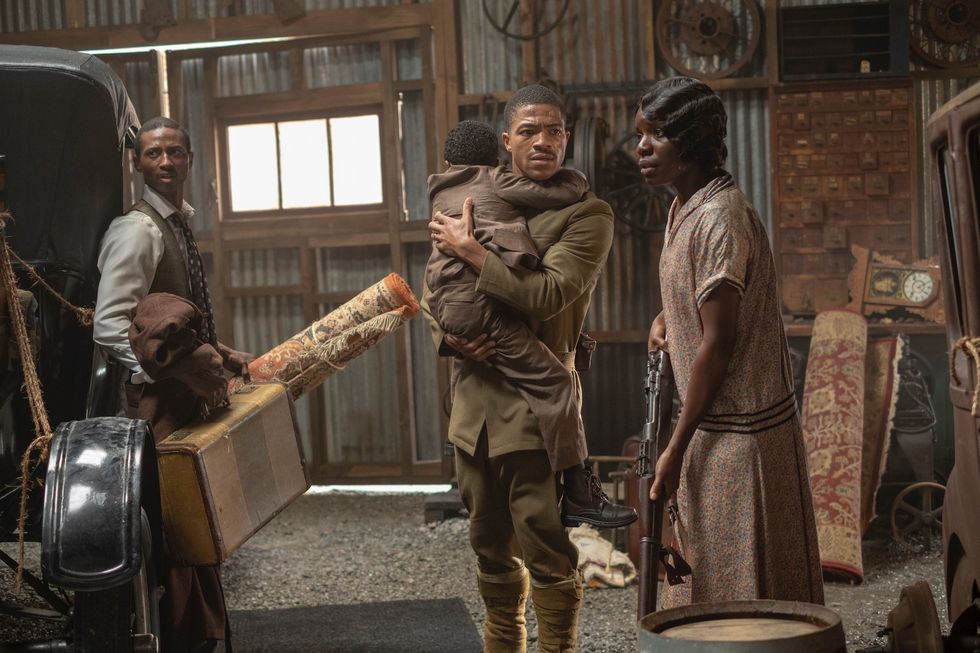Warning: This article contains major spoilers for both the Killers of the Flower Moon book and movie.
Killers of the Flower Moon was always a big deal—long before Martin Scorsese got involved. A year before the 2017 release of David Grann’s book of the same name, Imperative Entertainment ponied up a staggering $5 million for the adaptation rights with Leonardo DiCaprio attached to star and develop the title. Now, over six years later, the public will finally see Scorsese’s $200 million vision of the acclaimed book.
Grann’s novel is an investigation of a series of brutal murders of wealthy Osage in the early 1920s after massive oil deposits were discovered on their land. The Osage were awarded the rights to the profits from the oil, making them some of the richest people in the world. The film unfolds similarly but deviates quite a bit from Grann’s novel in ways that make it well worth experiencing both versions.
For those who are curious about the nature of the changes, we’re planning on breaking down what’s different but do want to issue a spoiler warning for both the novel and the film. There’s a whodunit element of the story that’s critical to the tale, so if you want to remain unspoiled, look away, but for those looking to know how the two overlap—or don’t—let’s dive into the major changes.
The Story’s Structure
Grann’s meticulously reached account is extensive, not only in painting a picture of what it was like in Oklahoma at this time but just about every single other aspect that comes along with the Osage discovering oil. While there are smaller details the movie hints at that we’ll cover shortly, the major difference between the two is this: Grann’s novel is focused on what’s basically two halves of the story: setting the stage about the murders and then how the FBI managed to solve the case.
The first half of the novel is a deep sociological exploration of the Osage’s wealth, detailing how they made their money: prospectors had to rent leases from the Osage, which led to this tremendous accumulation of wealth. But to add insult to injury, the US government declared that the Osage were incapable of handling these funds and forced them to deal with guardians. These “protectors” were usually the most prominent white citizens in the county and often found ways to make it extremely difficult for the Osage to access their money and swindled them in any number of ways, including overcharging for goods at their stores, implementing kickbacks and even stealing. After establishing the societal conditions, Grann then recounts the grizzly details about the murders and deaths around Mollie Burkhart’s (played by Lily Gladstone) family.

Lily Gladstone (left) and Leonardo DiCaprio in Killers of the Flower Moon
Apple
The second half of the novel is about the birth of the FBI, known then as the “Bureau of Investigation.” Sent to Osage County to investigate, J. Edgar Hoover largely viewed the Osage killings as a way of field testing the Bureau’s overall effectiveness—and raising his individual status within Washington. That’s not the same case for lawman Tom White (Jesse Plemons), who is a Gary Cooper-like, knightly figure who simply wants to do good. Grann goes deep into White’s back story as a frontier lawman and even into what his career became after solving the murders.
The film keeps most of this structure but centers it around the relationship between Mollie and Ernest (Leonardo DiCaprio) and reveals pretty early on that William Hale (Robert De Niro) is behind the killings of Mollie’s family and others in town. Scorsese is more interested in the dynamic between the two than he is in how the FBI came to the rescue, thus avoiding an outright white savior trope. Grann’s story is a tremendous artifact of research and investigation that would probably make Tom White consider adding him to his squad of lawmen. Scorsese’s approach is to centralize things in a more personal way.
Historical Context
Scorsese adds a few flourishes here and there, but one of the biggest standouts is the way in which he ties together the Tulsa massacre to the events unfolding in Osage County. Grann doesn’t bring up the 1921 destruction of Black Wall Street in his book, but Scorsese’s intent is clear: they’re both overwhelming examples of white violence perpetrated against wealthy minority groups. Both the Osage killings and the Tulsa massacre are events largely whitewashed from history—until events in culture brought them to the forefront. In the case of the Tulsa massacre, large swaths of the population (read: white) didn’t know about the event until it was depicted in HBO’s Watchmen series, and the Osage killings went unremarked upon until Grann’s book.

A scene from HBO’s Watchmen Episode 1, depicting the Tulsa massacre.
HBO
The Ending
Grann’s book ends with a modern coda. Upon one of his last visits to the reservation in 2015, Grann pieces it all together that the Osage murders expanded further and wider in scope than the tragedies that befell Mollie and her family. The book concludes on a decidedly tragic note: that descendants of those killed often have no resolution to what happened—and never will. That there was a massive conspiracy that extended to nearly every element of society in Osage County. Something that massive means the list of those who are motivated to kill an Osage was endless.

JaNae Collins, Lily Gladstone, Cara Jade Myers and Jillian Dion in Killers of the Flower Moon.
Apple
Scorsese’s ending, much like Grann’s, involves an act of self-insertion. The film picks up with a radio play about the murders, revealing details about what happened to Hale and Ernest. Then, in the film’s final moments, Scorsese himself appears as a narrator to reveal that after Mollie divorced Ernest and died, there wasn’t a single mention of the murders in her obituary—before cutting to an overhead shot of the Osage playing a drum and dancing together.
The act of self-insertion could be perceived as a nod to Robert Altman’s final film, A Prairie Home Companion, about the behind-the-scenes of a public radio play and a nod towards Scorsese’s (now well-documented) feelings about the end of his life. But it also serves as a way to remind the audience of the absolute importance of this story and what it means to the dark history of America. It’s a tour de force of the fourth wall breaking, a reminder that we cannot and should not look away from our past. We must reckon with it—and be better.

William Goodman
William Goodman is a freelancer writer, focused on all things pop culture, tech, gadgets, and style. He’s based in Washington, DC and his work can also be found at Robb Report, Complex, and GQ. He’s yet to meet a jacket or cardigan he didn’t love. In his free time, he’s probably on Twitter (@goodmanw) or at the movies.
>>> Read full article>>>
Copyright for syndicated content belongs to the linked Source : Men’s Health – https://www.menshealth.com/entertainment/a45586906/killers-of-the-flower-moon-book-movie-differences/































